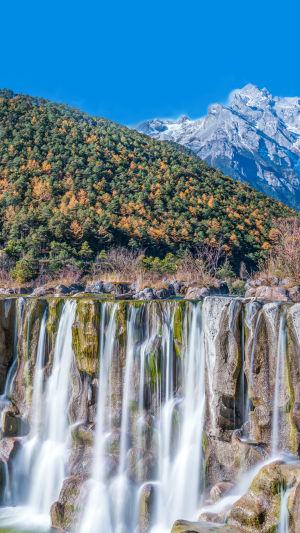Waterfall refers to the landscape formed by the water falling from a high place due to factors such as large terrain drops and changes in water flow speed when rivers, streams, etc. flow through relatively steep terrain.
Waterfalls usually present spectacular scenes such as cascading water, splashing water, mist, and roaring water, which attract many tourists to watch.
The height, width, water volume, drop, and other factors of waterfalls are different, and the landscapes formed are also unique. Some of the famous waterfalls are Niagara Falls, Victoria Falls, etc.
In addition to ornamental value, the waterfall also has certain scientific research value. The formation and evolution of waterfalls can reflect the history of geophysical and geological changes, and help to study the evolution of the earth and changes in the natural environment. At the same time, the hydraulics and meteorology of the waterfall are also the objects of research.
The best time to photograph a waterfall depends on a variety of factors, such as the location of the waterfall, weather and light, and more. Here are some suggestions for the best time to photograph waterfalls:
Avoid the hot sun and high temperature: In hot summer, especially at noon, the sunlight and heat around the waterfall will affect the shooting effect, making the color and details of the waterfall not vivid enough, and there are many people and tourists, making it difficult to shoot, so it is recommended Avoid the period of hot sun and high temperature.
Choose the right weather: In clear weather, sunlight will enhance the brightness and reflection of the waterfall, but too strong sunlight will also overexpose the picture and lose details, so it is recommended to choose weather with some clouds for shooting. In addition, on cloudy or rainy days, the flow and atmosphere of the waterfall will be outstanding, which is a good choice for shooting waterfalls.
Choose the right period: The best time period for shooting waterfalls is in the early morning and evening. The light in these two time periods is soft, which can create a more beautiful shooting atmosphere. In these two time periods, the angle of sunlight is also more suitable for shooting waterfalls, which can better highlight the beauty and characteristics of waterfalls.
Choose the time according to the characteristics of different waterfalls: different waterfalls have different shooting characteristics, and some waterfalls are more distinctive and beautiful in specific seasons or time periods, such as ice waterfalls in winter, fallen leaves waterfalls in autumn, etc., so it is recommended to know before shooting The characteristics and characteristics of the waterfall, choose the best shooting time.
Here are some tips for shooting waterfalls:
1. Use a tripod: Waterfall shooting requires a long exposure time, so using a tripod can avoid camera shaking during shooting and ensure the clarity and stability of the photo.
2. Choose an appropriate shutter speed: Waterfall shooting requires a longer shutter speed to express the dynamic effect of flowing water, generally a shutter speed between 1/10 second and 1 second is required. The specific shutter speed depends on the flow and velocity of the waterfall being photographed.
3. Use a neutral density filter: Use a neutral density filter to reduce the incoming light and slow down the shutter speed, making the waterfall more soft and natural. If you use a high-density filter, you can make the waterfall appear more detailed and textured in the photo.
4. Choose an appropriate aperture: In waterfall photography, an appropriate aperture size can control the depth of field and present the foreground and background of the waterfall clearly. Generally speaking, the aperture range from F8 to F16 is more appropriate.
5. Choose an appropriate white balance: The light around the waterfall is more complex, so choosing an appropriate white balance can make the color of the photo more realistic and natural. You can choose an appropriate white balance mode according to the environment and light around the waterfall you are shooting.
6. Pay attention to composition: In waterfall shooting, the proper composition can make the photo more artistic and expressive. Composition methods such as symmetry, balance, and diagonal lines can be used to highlight the beauty and momentum of the waterfall.
7. Adjust post-production effects: After shooting, you can use post-processing software to adjust the photos, improve color saturation, contrast and clarity, etc., to make the photos more vivid and vivid.





